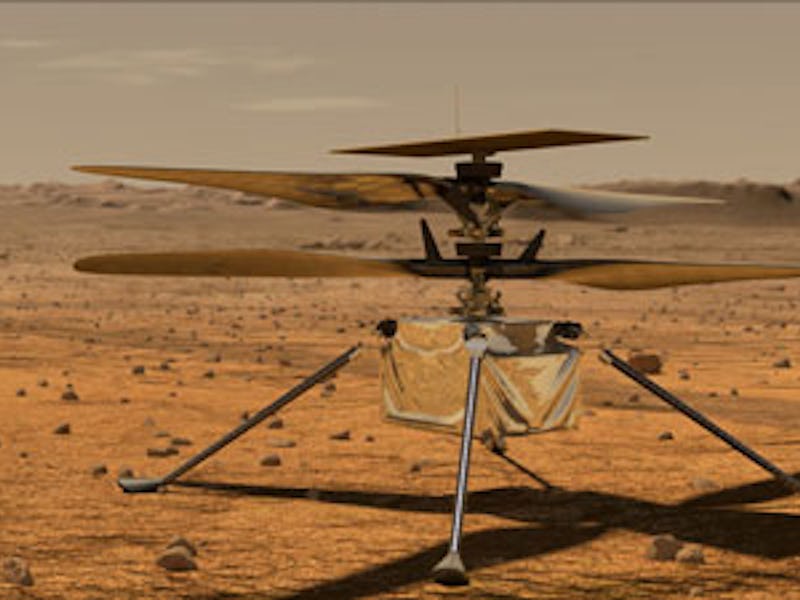Watch the Mars helicopter unpack its tiny legs like a baby calf being born
It's time for the helicopter to make it on its own.

First you must stand before you can fly.
After being tucked inside the Perseverance rover for over a month on Mars, NASA’s Ingenuity helicopter slowly unfolded itself in order to stand on its own four, tiny legs on the iron-rich soil of the Red Planet.
On Tuesday, NASA released brief footage of the rover lowering the helicopter to a position that would allow the rover to gently place it on the Martian surface.
Why did NASA send a helicopter to Mars?
Perseverance landed on Mars on February 18 with the quest to search for evidence of ancient microbial life that may have once lived there. However, the rover didn’t venture out to Mars on its own. It had the little chopper in tow.
Ingenuity is the first attempt to conduct a controlled flight on another world. (Two balloons were released on Venus in the 1980s by the Soviet Union.) The helicopter is only 19 inches tall, with two four-foot-long carbon-fiber rotors spinning in opposite directions.
"That's something that's never been done before in human history, and here we are," former NASA administrator Jim Bridenstine told reporters in June 2020.
Its small size allowed it to journey to Mars packed within Perseverance’s belly, which is where it has been since the pair landed on the Red Planet.
However, as Ingenuity prepares for flight, the rover must let go of its smaller companion.
In the brief footage captured by one of Perseverance’s cameras, the helicopter is being gently unpacked from its stowed position and unfolding its four legs like a wildebeest calf being released from its mother’s womb.
The tiny helicopter has stretched out its four legs, ready to touch down on Mars.
How does the Mars helicopter work?
A second image released shortly after shows all four legs of the helicopter fully stretched out and in a position to touch down on the rocky Martian surface. The entire process took a week.
Once it’s ready to stand on its own, Perseverance will gently deploy the helicopter at the center of a 33-foot square section selected as the helicopter’s airfield. The rover will then roll away, leaving Ingenuity to do its own thing and start charging up its solar batteries.
Once the helicopter is able to charge itself through its solar panel and communicate with the team through the Mars Helicopter Base Station on the rover, then they can begin testing the helicopter's flight abilities.
When is the Mars helicopter’s first flight?
Ingenuity’s first flight test is tentatively scheduled for April 8.
For its first flight, the helicopter will lift a few feet off the ground and hover in the air for around 20 to 30 seconds. Although brief, those first seconds of flight will be a major milestone in space exploration.
Subsequent flights will attempt further distances and higher altitudes than the one before it. The helicopter could fly for up to 90 seconds, to distances of almost 980 feet at a time and about 10 to 15 feet above the ground.
The helicopter’s testing will run through 30 Martian sols (a sol on Mars, its equivalent of a day, is about 40 minutes longer than a day on Earth).
How long will the NASA Ingenuity helicopter last on Mars?
Afterward, Ingenuity isn’t built to last for long in the harsh Martian atmosphere.
However, should its tiny legs successfully take off from Jezero Crater, Ingenuity will open the doors for a new way to explore other planets by sending aircraft to hover above their surface.
For instance, NASA is currently working on a drone mission to Titan, a planet-sized moon orbiting Saturn that is the only natural satellite with a substantial atmosphere. Titan is a prime target for the search for life in our solar system.
This article was originally published on